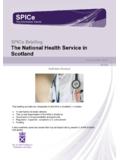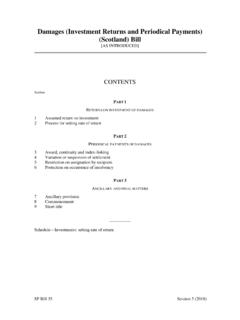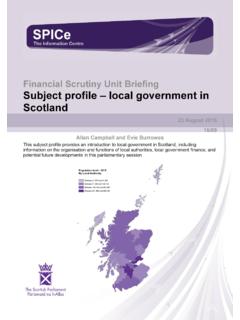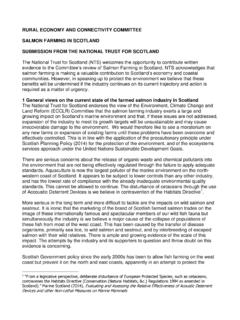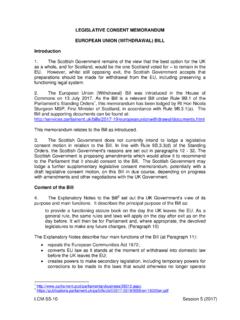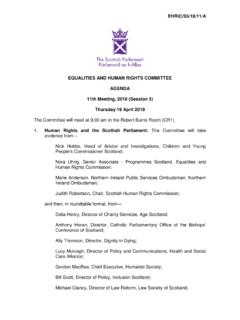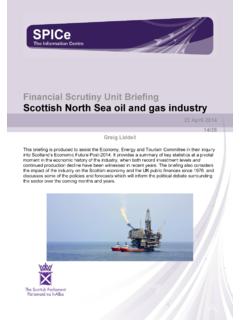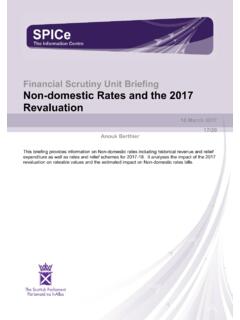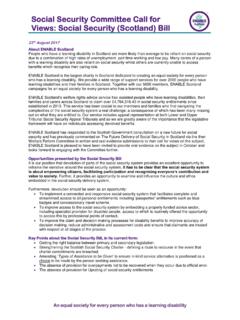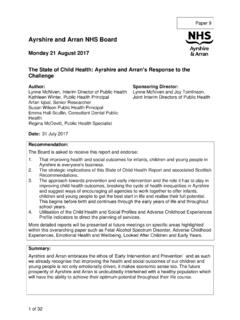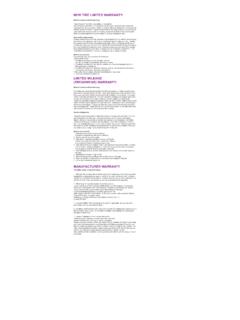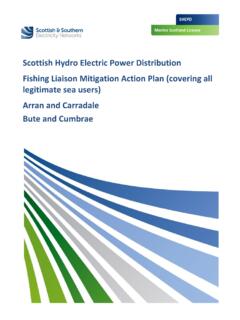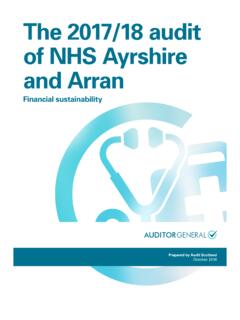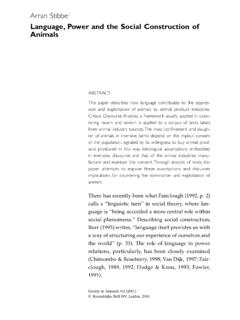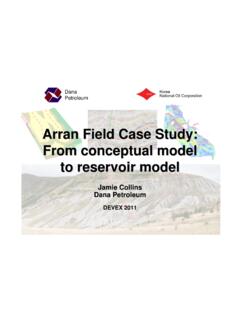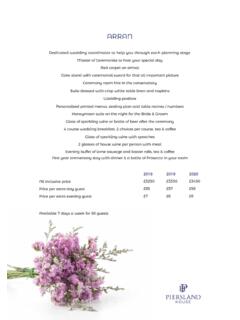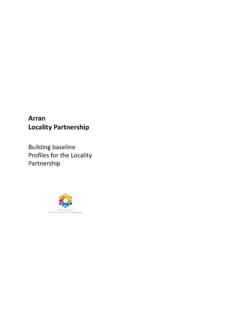Transcription of NHS Ayrshire and Arran - Briefing Scottish Parliament ...
1 24th November 2017 NHS Ayrshire and Arran - Briefing Scottish Parliament - Health & Sport Committee 2 Contents 1. NHS Ayrshire and Arran s Population Use of Services .. 3 Changing Use of Health and Care Services .. 3 Ayrshire s 3 Health Outcomes .. 4 Understanding Demand .. 5 2. NHS Ayrshire and Arran s Progress in delivering our Local Delivery Plan (LDP) .. 7 NHS Ayrshire and Arran s Annual Review 2016-17 .. 7 NHS Ayrshire and Arran Progress against LDP 2017-18 .. 7 Unscheduled & Urgent Care .. 7 Planned Care .. 9 Quality .. 11 3. Ayrshire s Integration Joint Boards (IJBs) - Performance and Progress .. 14 4. Financial Performance .. 18 Rising Pressures over the Last 3 Financial Years .. 18 The Current Financial Challenge.
2 18 Ongoing Work to Minimise the Financial Deficit .. 19 Cash Releasing Efficiency Savings .. 19 Best Value .. 19 Estates Master Planning .. 19 5. Creating a Sustainable Health and Care 21 6. Performance Reporting & Governance .. 23 Unscheduled Care .. 23 Planned Care & Waiting Times .. 23 Healthcare Acquired 23 Scottish Patient Safety Programmes .. 23 Patient Experience .. 24 Financial Monitoring .. 24 3 1. NHS Ayrshire and Arran s Population Use of Services Changing Use of Health and Care Services This Briefing focuses on NHS Ayrshire and Arran , but many of the challenges experienced by the NHS Board, and highlighted in this document, are common across the Health and Social Care system as a whole in Scotland, the wider UK and Europe.
3 Across Europe our environment is changing and health systems are facing significant challenges of aging populations, the rise in chronic diseases and ongoing constraints on public finances. We are living in a world where almost 40 percent of Europeans will be over the age of 60 by 2050, and where populations are shrinking. Furthermore we are witnessing: 80% of over 65 have at least one chronic disease (National Council on Aging); 50% have two or more chronic diseases (Centre for Chronic Disease and Control); 1 in 6 in the EU have a mild to serious disability (Papworth Trust); and Chronic disease accounts for 77% of total disease in Europe (European Chronic Disease Alliance). It costs three times more to look after a 75 year old and five times more to look after an 80 year old than a 30 year old.
4 Currently, chronic disease consumes 80% of the health care budget across Europe. Existing systems are designed to deliver acute care, and whilst these systems need to re-orientate to meet a changing landscape, they still need to continue to deliver acute care to meet extant demand. This is proving to be a universal challenge. Re-orientation requires a balance of resource allocation across the whole health and care system. Acute service provision cannot bear the burden of care as other parts of the system are reconfigured; and transformation can only happen when there is a foundation of operational and financial stability. Within the Scottish health and social care system the predicament is similar, but in its favour: Scotland s smaller size as a country supports a more personalised, less formal approach than in England.
5 The Scottish NHS has also benefited from a continuous focus on quality improvement over many years. It uses a consistent, coherent method where better ways of working are tested on a small scale, quickly changed, and then rolled out. Unlike in the rest of the UK, this is overseen by a single organisation that both monitors the quality of care and also helps staff to improve it. Nuffield Foundation July 2017. However, the challenges are real, significant and in need of urgent collective action. It is within this context that the detail within this Briefing should be considered. Ayrshire s Population The population within NHS Ayrshire and Arran is older than average and overall, is decreasing with the greatest population increases expected in the older age groups.
6 By 2020: over 23% of the population will be over 65 years of age, compared to across Scotland; the number of people aged 75 or over is projected to increase by 33% by 2024, compared to an increase of 29% projected for Scotland; the population is projected to further decrease by by 2024, compared to a projected increase in the Scottish population; and the working age population of Ayrshire and Arran (who consume less of our resources) is projected to decrease by by 2024, compared to a projected increase of for Scotland. 4 The local birth rate has been gradually decreasing over the last five years, and has been lower than the Scottish average for the last decade. In 2016, the birth rate was per 1000, compared to a rate of per 1000 for Scotland.
7 Accessibility issues exist for several remote and rural communities within NHS Ayrshire and Arran area, which covers an area of 3,369 square kilometres and includes two islands. This dynamic also makes it difficult to attract and retain staff in some parts of the region. Lifestyle factors are strongly linked to chronic disease, disability and deaths. These are more prevalent in more deprived areas, increasing inequality. Smoking of adults smoke compared to for Scotland, with significantly more smoking attributable admissions and smoking in pregnancy compared to the national average. Alcohol and drugs There are significantly higher rates of alcohol and drug-related hospital stays in Ayrshire compared to Scotland. Diet of Primary 1 children are obese, significantly higher than the Scotland level of Physical inactivity There are significantly lower rates of active travel to work in Ayrshire and Arran than the national average.
8 Mental health There are significantly lower levels of wellbeing than Scotland as a whole, and higher levels of potential psychiatric illness. Analysis of primary care data showed that there have been upward trends over the last decade within Ayrshire and Arran in the numbers of people recorded with dementia, new diagnosis of depression, and severe and enduring mental illness. Health Outcomes Increased proportion of lives spent in poor health - People are living longer but the length of time that they spend in good health is not increasing. More years spent living in poor health creates additional demand for health and social care services. Men spend an average of years and women spend an average of years in poor health, which is longer than the Scottish average of years for men and years for women.
9 Disease prevalence and main causes of death Cancer is the main overall cause of death with 1,257 deaths in total in 2016; 1,247 people died of circulatory diseases in 2016, and 647 died of respiratory diseases. Premature mortality describes deaths under the age of 75 years in the population and it is considered to be a useful indicator of overall health. Figure below shows that overall mortality rates and premature mortality rates are consistently higher than Scotland for all the main causes of death 5 Figure : Premature (under 75s) age-standardised death rates compared to all ages, for cancer, circulatory and respiratory disease, Scotland and Ayrshire and Arran , 2016 Significant ongoing health inequalities in life expectancy are evident between the most and least deprived communities.
10 These affect the quality and quantity of many people s lives and result in earlier onset of long term conditions, higher levels of premature death and higher use of health and social care services. There is an year difference in life expectancy between men living in the most and least deprived areas. Women living in the least deprived areas have a life expectancy of compared to for women living in the most deprived areas. Average life expectancy for both men and women in Ayrshire and Arran is below the national average. Health service usage there is significantly higher number of hospitalisations for a range of diseases compared to the Scottish average, including coronary heart disease, chronic obstructive pulmonary disorder and asthma.

